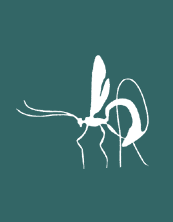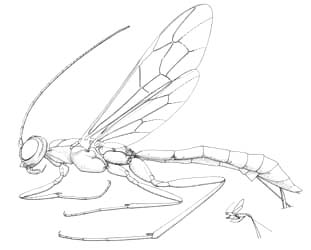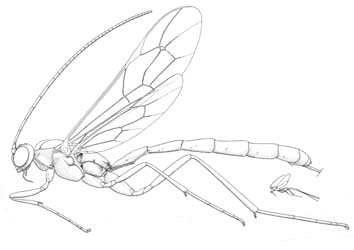
GIN Home
Ichneumonid Morphology
Subfamily Key
Lists of World Genera
Acaenitinae
Brachycyrtinae
Collyriinae
Lycorininae
Ophioninae
Poemeniinae
Rhyssinae
Stilbopinae
Xoridinae

By Ian D. Gauld & David B. Wahl

Podoschistus vittifrons |

Poemenia hectica |
The subfamily Poemeniinae consists of slender elongate ichneumonids with long ovipositors, superficially resembling rhyssines and some pimplines. Most are rather rarely collected; the large tropical species Rodrigama gamezi, which is bright yellow and nearly 200 mm in length, has only been found clustered around a single moribund tree in Costa Rica. As one would expect from their morphology, poemeniines are parasitoids of insects mining in wood, or of other insects living in such excavations.
Classification and diversity
The Poemeniinae is a small cosmopolitan subfamily consisting of three tribes: Rodrigamini, Pseudorhyssini and Poemeniini (Wahl & Gauld, 1998). Until quite recently (e.g. Townes, 1970) the subfamily included only species now placed in the Poemeniini, but the enigmatic genus Pseudorhyssa (formerly in the Pimplinae) was shown to have a suite of derived characters placing it with the poemeniines (Eggleton, 1989; Gauld, 1991). The Neotropical Rodrigama was also found to share these characters and so was placed in the expanded Poemeniinae (Gauld, 1991). Poemeniines constitute the sister group of the Rhyssinae, both of which form the sister group of the Pimplinae; all three subfamilies are currently placed in the informal subfamily grouping Pimpliformes (Wahl, 1990; Wahl & Gauld, 1998).
Worldwide, there are 78 described species in ten genera (Yu & Horstmann, 1997), and the subfamily is perhaps most species-rich in the eastern Palaearctic region. Four genera and nine described species occur in North America: Neoxorides, Podoschistus, Poemenia, and Pseudorhyssa, with the highest species-diversity in northern forests. Of the two other New World genera, Rodrigama is only known to occur in Costa Rica, whilst Ganodes is widespread in tropical America from Mexico to southern Brazil (Gauld, 1991).
The general biology of Poemeniinae
Poemeniines are believed to be idiobiont ectoparasitoids of the immature stages of endopterygote insects boring in wood, living in borings in wood (Townes, 1969), or in one case, as cleptoparasitoids of other wood-boring insects (Spradbery, 1969). However, the exact host-relationships have not been ascertained in most tropical genera.
Species of Pseudorhyssa are cleptoparasitoids of rhyssines. The female Pseudorhyssa locates the ovipositional boring of a rhyssine and then inserts her own slender ovipositor down it. She lays a large egg which ecloses rapidly, producing a particularly well-armoured first instar larva which destroys the rhyssine egg or larva before consuming the host paralysed by the adult rhyssine. Species of Podoschistus and Neoxorides are parasitoids of wood-boring beetles of the families Cerambycidae, Buprestidae and (less commonly) Curculionidae in both conifers and broad-leafed trees (Townes & Townes, 1960). Species of Poemenia seem principally to be parasitoids of Crabronidae (especially species of Passaloecus) and Megachilidae nesting in old borings in timber and woody galls (Carlson, 1979: Fitton et al., 1988).
Diagnosis
Small to large ichneumonids, fore wing length 4.0 to 26.0 mm. Clypeus varying from large, lenticular and evenly convex, to small, quadrate, and flattened; separated from supraclypeal area by epistomal suture; apex truncate or weakly concave (strongly concave in Rodrigama), with prominent median tubercle in Pseudorhyssa. Malar space without subocular groove. Mandible short and stout, apex with one or two teeth (if one tooth, then chisel-shaped). Antenna with flagellum filiform; males without tyloids. Gena with fine to coarse denticulation (Poemeniini). Foramen magnum laterally expanded. Ventral posterior corner of propleuron without strongly produced lobe. Pronotum with epomia absent dorsally, ventrally sharp and on raised ridge that is close to and more or less parallel with anterior pronotal margin. Mesoscutum either 1) with prominent transverse rugae (Pseudorhyssa), or 2) smooth or sometimes with transverse rugulae along notauli and medially. Notauli strongly impressed, generally more or less meeting centrally and extending posteriorly towards scuto-scutellar groove. Sternaulus absent. Epicnemial carina present or absent. Posterior transverse carina of mesothoracic venter absent. Propodeum long, with spiracle at or before midpoint (Poemeniini). Propodeal carinae reduced, varying from only median longitudinal carinae and posterior transverse carina present, to only posterior transverse carina present, or carinae completely absent. Tarsal claws ranging from simple to having a median tooth in various combinations of sexes and legs. Fore tibia with denticles on dorsal surface; dorsal apical tooth absent. Fore wing with areolet present or absent, when absent vein 3rs-m basad vein 2m-cu; vein 2m-cu with two bullae. Hind wing with vein 1/Rs = vein rs-m; veins 1-Rs, 1-M and 2-Cu tubular to nebulous; vein 2/Cu very close to, or appearing to originate from, vein M. Metasomal insertion on propodeum between hind coxae. Metasoma cylindrical or dorsoventrally depressed. Metasomal segment 1 with T1 narrow anteriorly, posteriorly evenly broadened, with spiracles in front of midpoint; glymmae present (Pseudorhyssa, Neoxorides, Podoschistus) or absent; T1 and S1 fused except in Pseudorhyssa. T2-4 without grooves except in Pseudorhyssa (T2 with anterolateral grooves) and Rodrigama (T2-4 with antero- and posterolateral grooves delimiting a more or less rhombic central area). T8+9 of female elongate, apex modified as a horn or boss, or elongate and dorsally flattened (Cnastis). Hypopygium of female short, transverse. Ovipositor projecting beyond apex of metasoma by at least 1.5x length of hind tibia and frequently longer; upper valve without dorsal subapical notch, weak widely-spaced teeth present only in Pseudorhyssa; lower valve enclosing upper valve and its apex with conspicuous teeth.
The genera of Poemeniinae present in the Nearctic Region
- Neoxorides Clément, 1938. Holarctic: three described Nearctic species (HOD)
- Podoschistus Townes, 1957. Holarctic, Oriental; one described species in Nearctic (vittifrons Cresson) (HOD)
- Poemenia Holmgren, 1859. Holarctic, Oriental; four described Nearctic species (HOD)
- Pseudorhyssa Merrill, 1915. Holarctic; one described Nearctic species(maculicoxis Kriechbaumer) (HOD)
Identification and resources
Like the rhyssines, Pseudorhyssa has strong transverse rugae on the mesoscutum, but unlike rhyssines it has impressed oblique grooves anteriorly on tergite II and propodeal carinae. The epicnemial carina is absent in poemeniines, and most genera have denticles on the dorsal 0.5 of the gena.
Key to genera of Nearctic Poemeniinae
· Downloadable pdf file of the key is available here
· Downloadable pdf file of the key figures is available here
Hymenoptera Online Database (HOD)
A key to the Nearctic species is provided by Townes & Townes (1960).